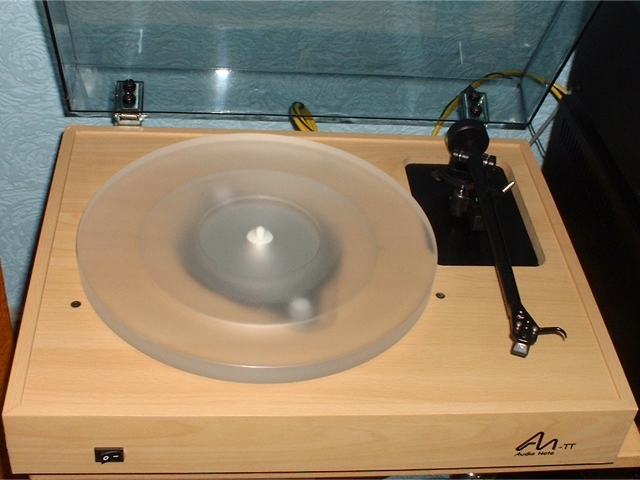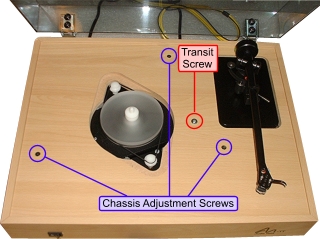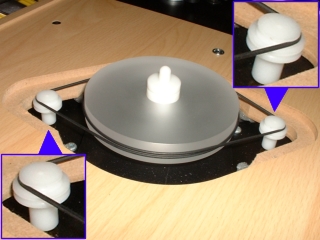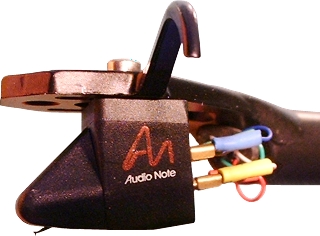|
||||||||||||||||||
|

| Introduction |
Firstly, I had to build a phono stage for my, now, line-only system. To facilitate this, I built the newly released Audio Note Kits Kit1 Phono Stage Signature. Once finished, I was able to hook up my old Rega turntable and began listening to my old records once again. In no time at all, I was converted. The sheer musical presence superseded my CD set-up. Still though, something was lacking - there were still aspects that CD had that my turntable lacked such as the tightness of the bottom end and more extended top end (although treble content was now more satisfying) etc. The Rega was also quite noisy; picking up hum every time the stylus hit the record.
After various routes of investigation, I decided that I would try to get hold of an Audio Note TT-1/Arm Two/IQ2. The TT-1 had outstanding reviews and came highly recommended although its most common configuration was with Arm1 and IQ1.
I was fortunate enough to be put in touch with Mario who works out of the Audio Note factory in the UK. Mario is a very dedicated individual who looks after Audio Note's audio shows and demonstrations (including home demos around the UK and parts of Europe).
Although TT-1 and TT-2 manufacture had moved out of the UK, Mario said it may possible to build me turntable using parts that were still available in the UK factory including a slightly damaged chassis that could not be used to build a retail model simply because of the way it looks.
Mario questioned my choice of TT-1/Arm Two/IQ2 and advised me that, although a little more expensive, a TT-2/Arm One/IQ2 would be far superior in terms of tighter bass, transient performance, image depth, etc. In addition, upgrading the turntable would be simpler because upgrading a TT1 to a TT2 was a far more difficult task than upgrading an Arm1 to Arm2. The former would definitely mean a return to the factory, whereas the latter could be done elsewhere - possibly myself with the right instructions from himself. Also, it is not always possible to upgrade a TT1 to TT2 because some of the chassis that they use for the TT1 simply don't allow it.
Although Mario confirmed that he had all the necessary parts at the factory, he was reluctant to send the TT-2 to me in the post, as he didn't want to it to get mishandled by the postman and lose its factory set-up that is, of course, an important part of the build. Fortunately, the local Hi-Fi show was due in a few weeks time and I arranged to pick it up from him then.
So, it was the last day of the show. I had arranged to see Mario at the end of the show so that he would have time to demonstrate the turntable to me. First, before visiting the Audio Note room, I had a wonder around the show with my eldest son (his first time at a Hi-Fi show) because we had a couple of hours to kill. The thing that struck me about the show was the lack of good sound! I had not been to a show for a great many years and I am certain that back then there were more things worth listening to. Not today though - so what's going on? Only two rooms that I visited were what I would consider Hi-Fi. Granted, there are more home cinema set-ups than ever before but there were still a lot of companies selling Hi-Fi that sounded really bad. At first, I thought it was my old ears but my son also concurred with me as to what sounded good and what didn't.
Before long, I had seen enough. It was time to visit the Audio Note room. Interestingly, this was the only room that had its door permanently closed. It also had a couple of signs on the door. One stated that there was no home cinema in the room while the other hinted that you shouldn't enter the room unless you are a music lover (I forget the exact wording). What an intriguing way to do business - I entered. As you may guess, there wasn't a permanent influx of people going in and out of the room and the people who were didn't want to move. Now this was Hi-Fi. The set-up was quite a modest one for Audio Note and consisted of TT-2/Arm2/IO1/Step-up analog front end, CDT-Two/DAC1.1 Signature digital front end, Meishu phono integrated amplifier, and E/Lx speakers. Vast arrays of different types of music were played to show the system's versatility. Not a single person left the room mid-song. In fact, I got the impression that most people would have stayed there all day if they could - it was that kind of relaxed atmosphere.
This was the first time that I had heard the 'E' speakers and, even though it was one of their lowest models in the E range, they were incredibly impressive. The integration between tweeter and woofer has to be heard to be appreciated and the bass is truly impressive for a speaker of this size (for any size in fact). In fact the whole frequency spectrum remains in full control despite the complexity and intensity of the music.
Time was ticking by and the show was drawing to a close. After everyone had gone, Mario set-up my turntable in the same system by simply replacing the existing TT-2 with mine, bypassing the step-up transformer. I was quite surprised at the amount of time he gave up for my own personal demonstration as he had hundreds of miles to travel to get home that evening. We spent quite some time listening to different types of music and Mario pointed out the various different nuances between this and the previous turntable as well as many other invaluable insights. This was a very important thing for me because I had been given the opportunity to listen to my turntable in a system that I had become used to listening to as well as being able to use the memory of this to compare to my own system at home that is quite similar in terms of amplification.
The important thing during our little meeting was the music, not the deal; that was very refreshing. It was actually me who finally broke off the meeting because I unfortunately had somewhere else to get to (I didn't think that Mario would give up so much of his time). So, my new TT2 was carefully bundled into my car and off we went back home. It would be the next day before I would have chance to set everything up.
I would recommend to anyone who lives in the UK, and doesn't have an Audio Note dealer in their area, to contact Mario and discuss any potential Audio Note purchase. He is very knowledgeable about everything Audio Note (as you would expect) and is a very nice chap to boot. If it is not possible for you to go to Audio Note, they will consider coming to you; circumstances permitting.
Mario can be contacted on 07867 973948 during normal UK daytime hours.
| Turntable Overview |
Both the TT1 and TT2 are based on the award winning Dunlop Systemdeck IIX. Audio Note have taken its basic design and improved on it in a number of areas. Both models have a fully floating, three point, level-adjustable suspended sub-chassis that isolates the platter and arm from the outer chassis, motor, and shelf or support. If I remember correctly, the sprung sub-chassis is tuned to around 1Hz.
Both the platter and sub-platter are individually machined from a single block of acrylic. The platter has a label-sized recess on its top to accommodate the record's label and a wider recess on the bottom, providing clearance for the pulley system. One of the reasons that acrylic is used is that it has some similar properties to vinyl itself so that when a record is placed on top of it, it acts like a mechanical extension of the record. Therefore, with this kind of platter, no mat should be used.
The TT1 and TT2 use a transit screw to lock the sub-chassis into position during transport. This must be removed before playing. The sub-chassis can be leveled using three adjustment screws although this should only be necessary if you are fitting a new arm or cartridge etc. that may have interfered with its basic leveling done at the factory.

Drive is provided via 'o' section 'rubber' belts (one in the case of the TT1 and two for the TT2). The TT2 improves on the TT1 by the addition of a second motor that is positioned exactly opposite the first. This has the effect of equalising the pulling stress on the platter assembly as the two directly opposing belts drive it, improving torque and speed stability. It also has a modified power supply. Two 24-pole precision synchronous, high torque motors are used and are mounted on anti-vibration assemblies.

Speed changes (33/45 rpm) are done manually by removing the platter and changing the belts onto the alternative pulley groves.
The clear plastic lid is held on with spring-loaded hinges. Audio Note recommends that the lid be in the up position when playing records and ideally off altogether for the best possible sound.
Dimensions, including lid and feet, are 47cm x 36cm x 17cm.
| Tone Arm Overview |

There are currently four tone arms available under the Audio Note brand. The most expensive (the AN-1s) will not be detailed here as it is a rather exotic, made to order, and very expensive beastie that is probably more than a few years away from my grasp.
That leaves us with the Arm1, Arm2, and Arm3. I have initially gone for the Arm1 with the view of upgrading to the Arm2 or Arm3 in the future.
| Arm1 |
| Arm2 |
| Arm3 |
| Cartridge Overview |

Audio Note has a large selection of cartridges. Most of these are in the IO range and are low output moving coil designs. Some of these upper range cartridges use very high quality materials such as silver coils, ALNICO magnets, etc. While the highest in the range (the IO Ltd.) uses a separate precision DC power supply to energise its internal electromagnets.
The IO range is unfortunately out of my particular price range at present. This leaves us with the IQ Moving Magnet range. It was explained to me that it is impossible to make a cheap moving coil cartridge without making an awful lot of compromises that adversely affect the resulting sound. So instead, Audio Note decided to make the best possible Moving Magnet design for the lower price bracket instead. The IQ range is actually manufactured in the Goldring factory to Audio Note's specification and comprised of three models - the IQ1, IQ2, and IQ3 (or IQI, IQII, IQIII). The three models are actually the same cartridge and simply have different stylus profiles. They can, therefore, be upgraded by simply changing their styli.
I have the IQ2 cartridge fitted to my turntable. This is in the middle of the IQ range. It will be very interesting to listen to this cartridge because my previous turntable used the popular Dynavector 10x high-output moving coil cartridge. I never rated the MM cartridges that I remember in friends' systems in the old days because of their harsh high frequency characteristics but I do have high expectations for the Audio Note synergy - so let's see.
| Things to get used to |
Lifting the cuing arm is a little difficult; also down to the suspended chassis. If you don't take it easy with the cuing lever, lifting it slowly, it is possible to cause the sub-chassis to bounce while the stylus is still on the record. This is because it is quite stiff. Hopefully this is down to the arm being new and will become looser after a while.
The spindle that fits through the hole in the record makes for a very tight fit on some records requiring quite some force to mount and dismount them. I see two possible solutions to this. Either switch off the player before mounting and mount the record by holding onto each side of the platter with your fingers and press the record's label area with your thumbs. Or, make the hole slightly bigger. Because about three-quarters of my existing record collection fit on the turntable without a problem, I have gone for the second option - it only takes a slight scraping with a scalpel blade in most cases.
To me these are minor gripes because the quality of the playback far exceeds any inconvenience.
| Listening |
The first thing I did while I was unpacking and taking pictures of the TT-2 was to play a record on my old Rega set-up so I could do a comparative listen as soon as the TT-2 was ready. I chose Ry Cooder - Jazz; an album that I enjoy a lot with very nice instrumentation, voicing, and that all-important feeling.
The first thing that I noticed was an extra sense of space and air in the reproduction that I hadn't heard in a domestic environment for a very long time (and never in my own home). It was also much easier to relax into the music and enjoy the detail.
My biggest fear was about how the cartridge would reproduce the higher frequencies because I was, after all, moving from high output moving coil to a moving magnet design. I am very glad to say that the high frequencies are spot-on and very much superior to my old Dynavector 10x cartridge. The IQ2 seems to have more upper extension but without being too sparkly or rough at the edges; giving cymbals back their magical natural shimmer.
Bass too is greatly extended; even more so than my digital set-up, in fact.
The TT-2 easily betters my previous turntable in about every conceivable way and I could never consider returning to it. The TT-2's ability to present imaging is superb and very impressive indeed. It is now very easy to pinpoint the positions of instruments within a mix - whereas my old turntable tended to blur the mix and approximate instrument positioning.
What I find most impressive is this turntable's ability to bring the most out of live recordings. I had always shunned away from live recordings in the past (except for classical pieces, of course) because they always tended to sound rather dull, over-powered, and (forgive the pun) lifeless. The TT-2, however, seems to have the ability to present live recordings in a truly energetic, yet effortless, manner.
| Conclusions |
The amount of detail that it is capable of reproducing is exceptional. Never does the detail suffer as a result of increasing complexity and multi-layering. I often pick out an individual instrument to follow in complex music (I have always been like that with music) and never, in my own home, has it been so easy to do this.
No particular frequencies are over-emphasised, presenting a very realistic musical spectrum.
Having heard the main demonstration TT-2 at the Hi-Fi show alongside mine, I know that my turntable has excellent potential for upgrades well into the future. It depends on how far I wish to take it. It appears that what you get as you upgrade through the range is increases in tonality and detail retrieval. That is not to say that my TT-2 lacks either of these; I would have gladly concluded that this was the ultimate in suspended sub-chassis turntables if I hadn't heard the upgraded version of the same one.
I am extremely happy with my new turntable purchase; as I have been with all my Audio Note equipment - whether it be in kit form or with their finished products and would recommend their equipment to anyone as a way to go forward to fulfill their quest toward true and better Hi-Fi reproduction. You just have to make sure that you don't listen to their highest spec systems too soon because, if you don't, you won't know how far you really have to go for perfection and will be happy with the best you have heard to date.
So, as for my own H-Fi, I now have to consider what needs upgrading next. The only things that are not Audio Note now are the speakers and the speaker cables. After hearing their modest AN E/Lx speakers, and being so impressed by them, the only way to go is to upgrade my speakers; I can always upgrade the turntable at a later time. Therefore, I will now begin saving up for one of their speaker kits (probably the Kit3 with its 98dB all-silver drivers). That is unless I come across a good second-hand pair of finished product ones first.
Written by Paul Brookes
Published 21st February 2006
| Turntable | Audio Note TT-2 |
| Arm | Audio Note Arm1 |
| Cartridge | Audio Note IQ2 |
| Phono Stage | Audio Note Kit1 Phono Stage Signature |
| Amplifier | Audio Note PQ Signature Kit1 |
| Interconnects | Audio Note AN-v |
| Speakers | Tannoy DC 386 - 15inch dual concentric in custom cabinets |
| Speaker Cable | Unknown silver multi-stranded |
| CD Transport | Audio Note CDT-One |
| DAC | Audio Note DAC Kit 1.1 |
|
|
